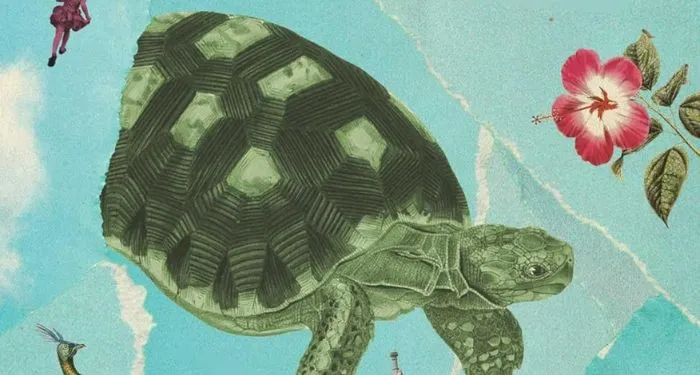“When you have seen the great elevated pure nature of Greenlandic nature you feel closer to the Creator and [understand] the pettiness of civilized life,” the Danish artist J.E.C. Rasmussen wrote to his fiancée after he returned from his first, life-changing expedition to the Arctic Danish colony in 1872. I got an idea of what Rasmussen meant last May in Nuuk, Greenland’s capital, as I stood on Hans Egedesvej, the street named after the Danish-Norwegian missionary who founded the colony in 1721.
Nuuk was in the midst of a “late winter” blizzard, as the locals call it. The transcendent scene, complete with shimmering, ice-covered mountains, reminded me of the photorealistic Greenland landscapes of Rasmussen, who perished after he jumped—or fell—from the deck of a Danish naval brig during his return from his second expedition to the Arctic territory in 1893. Suddenly out of the snow-driven mist appeared a warship moving swiftly, at perhaps twenty knots, before it disappeared. For a moment I thought it might be American. “No, it’s one of ours,” the desk person at the Greenland National Museum and Archives told me with a rueful laugh.
Nearly a year after Donald Trump first threatened to seize their homeland, the 57,000 residents of Greenland—as well as the six million other subjects of the Danish king Frederik X—continue to be in a state of suspense about his next move against the autonomous territory. The week before my visit, Trump refused to exclude the use of military force in his quest to acquire Greenland. “I don’t rule it out…. I don’t rule out anything,” he told NBC. “We need [Greenland] very badly for national and international security.”
Rufus Gifford, a former US ambassador to Denmark, disagreed: “Every Danish and Greenlandic leader at this point…has said that Greenland is not for sale and will not become part of the United States,” he told CNN in April. Ulrik Pram Gad, a Greenland expert at the Danish Institute for International Studies (DIIS) in Copenhagen, pointed out that “the trouble is that everything the US could rationally want it already has from the agreements it has made with Denmark. So what more could Trump want?”
Mette Frederiksen, the Danish prime minister since 2019, has been saying much the same thing since Trump expressed his determination to get Greenland “one way or the other,” as he put it in an address to Congress in March. “When you ask us to spend more on defense, we do,” Frederiksen declared during a “unity” visit she made to Nuuk on April 3, in remarks clearly aimed at Trump.
And when you ask of us to strengthen security in the Arctic, we are on the same page. But when you demand to take over a part of the Kingdom of Denmark’s territory…what are we to believe in about the country we have admired for so many years?… You cannot annex another country!
But Trump is not listening. “Something could happen with Greenland,” he vowed to NBC in May. Although he has said relatively little about the matter since, there is no indication that he has abandoned his designs on the mineral-rich, 836,000-square-mile island. On June 17, in what some Danes saw as an ominous sign, the Pentagon announced that it was shifting responsibility for the island from US European Command to US Northern Command, which covers the US, Canada, Mexico, and parts of the Caribbean. “Trump’s interest in Greenland is not going away,” Rasmus Søndergaard, an analyst at the DIIS, told me recently. Frederiksen certainly doesn’t think so. “There is perhaps a feeling that we can breathe a sigh of relief,” she said at the opening of the Danish parliament in September. “It is my belief that we cannot.”
America’s relationship with Denmark is in tatters. Last March a YouGov poll showed that the percentage of Danes who viewed the US favorably was down from 48 percent in August 2024 to just 20 percent—the greatest change in attitudes toward the US of any European country. That same month came the back-to-back insults of Trump’s congressional address and Vice President J.D. Vance’s peremptory visit to the US Space Force base at Pituffik in northern Greenland, where he scolded Copenhagen for “not doing a good job” of providing security “for the people of Greenland.”1
I encountered numerous illustrations of anti-Americanism during my visits to Denmark this year, from the scowls I received when I made the mistake of asking for a Coke at a Copenhagen bar to an anti-Trump diatribe by Bertel Haarder, a former minister of education. “Betrayal” is not too strong a word to describe how Danes—particularly the older conservative generation, many of whom, like Haarder, studied in the US—feel about Trump. “I used to love America,” Haarder wrote. He was particularly annoyed, as were both Danes and Greenlanders, by Trump’s comments on Greenland in his congressional address and the laughter they provoked on the Republican side of the aisle. “Why was that funny!” he asked. “Why this American contempt?”
One of those who shares Haarder’s anger is the Inuit elder Aqqaluk Lynge. “[Trump] mentioned Greenland like it was a toy or something,” Lynge, who once represented the Arctic Inuit in the United Nations, seethed to 60 Minutes. “It was ugly.”
During my stay, Greenlanders were still recovering from the mortifying visit of Donald Trump Jr. to Nuuk in January, which included a claque of right-wing influencers offering lunch to homeless people in return for their smiling and putting on MAGA hats. “It was a circus,” said Corinne Halling, a Greenlander of mixed heritage who works at the Hotel Hans Egede, the city’s largest hotel, where Trump Jr. hosted a luncheon for his guests.
One of the unintended effects of Trump’s threats against Greenland is that they have brought Danes and Greenlanders together, at least in the short term. Meanwhile, for those Danes on the left who were never particularly enamored of the US, Trump’s antics have only confirmed their feelings. Danish-American relations were further roiled on May 6 when The Wall Street Journal reported that Tulsi Gabbard, Trump’s director of national intelligence, had ordered the NSA and the CIA to increase their surveillance of the Greenland independence movement. Danish foreign minister Lars Løkke Rasmussen summoned the US chargé d’affaires, Jennifer Hall Godfrey, for a dressing-down. “You cannot spy against an ally,” Frederiksen protested.
Danish hackles were raised again in August, when the Danish Broadcasting Corporation reported that three Americans associated with Trump were conducting covert “influence operations” in Greenland. Rasmussen called in Godfrey’s successor, Mark Stroh, for an explanation, and he had none. “Dialogue is of course the way forward,” Jens-Frederik Nielsen, the newly elected prime minister of Greenland, said in April as he stood with Frederiksen in Nuuk’s harbor, “but [there] is great uncertainty [because] there is no dialogue now.” That uncertainty remains.
Many Northern European nations have a word, often as not an untranslatable one, that conveys a state of well-being. The Finns have sisu, the Dutch gezelligheid. Danes have hygge. A poster in the room of my hotel in Ærøskøbing, a town on Ærø, a tadpole-shaped Danish island in the southern Baltic Sea with a population of six thousand, explained it: “Hygge. 1. Hard to explain and even harder to pronounce. 2. A calm, comfortable time with people you love. 3. A complete absence of frustration, or anything emotionally overwhelming.”
I got a fair idea of what hygge means on the ferry from Svendborg to Ærøskøbing. The trip from Copenhagen to Ærø is a bit of a schlep, involving two trains and a mile-long walk to catch the ferry. However, once the smiling officer welcomes you aboard, hygge kicks in. People snooze. Mothers cuddle their children. The feeling continues as one walks up the gently sloping, postcard-perfect streets lined with eighteenth- and nineteenth-century half-timbered cottages, and when one dines with locals at the cozy taverns in town, where the gossip tends to revolve around the ferry.
Nevertheless the hygge quickly dissolves if one brings up Greenland. While none of the Danes I met in Ærø or Copenhagen had actually been there, they all seemed to have opinions about it. Along with their understandable anger at the US, Danes seem to feel guilty about the autonomous territory and the way the indigenous Inuit population has been treated over the years. There is much to feel guilty about. In the 1950s twenty-two Inuit children between the ages of five and nine were brought to Denmark to learn Danish. The “little Danes” experiment, as it was called, was part of the government’s effort to expedite the assimilation of the Inuit people into Danish society when Greenland was incorporated as a county in 1953. The putative objective was to nurture a Danish-speaking native elite who could properly administer the island. But many of those who returned to Greenland had lost fluency in their native language and, unable to communicate with their parents, became drifters, turning to alcohol or begging on the icy streets of Nuuk.
At about the same time thousands of Inuit girls, some as young as twelve, were fitted with IUDs by Danish doctors, mostly without their consent. The supposed aim was to curb the growth of Greenland’s population in order to reduce the financial burden on Copenhagen of supporting the industry-poor, mineral-rich county.2 Every Greenlander knows of these two cases, and so do most Danes.3
Ærø is the birthplace and home of J.E.C. Rasmussen. The largest repository of his works is the maritime museum in Marstal, Ærø’s largest town. The artist, who suffered from lifelong depression, had mixed feelings about Marstal, which he left in despair in 1893 before his final, fatal expedition to the vast island two thousand storm-tossed miles away.
Rasmussen’s love for Greenland is reflected in his soaring allegorical landscapes of Kalaallit Nunaat, as Inuits call their homeland, which recall the work of Caspar David Friedrich, an influence on many Danish artists of the time. Rasmussen was arguably more skilled at painting icebergs and ships and waves than people, and his treatment of the Inuit he encountered, at least from today’s vantage point, tends toward the paternalistic.
Marstal is also the home of the world’s two foremost authorities on Rasmussen, the Danish novelist Carsten Jensen and Karsten Hermansen, the maritime museum’s historian, each of whom has written extensively about him. “Of course I admire Rasmussen’s work,” said Jensen, who is best known for his novel We, the Drowned, about the rise and fall of Marstal’s maritime industry, in which Rasmussen is discussed, “but I am more interested in his crisis and existential journey, as well as his place in Danish history. He interests me because his work involuntarily shows the shortcomings of the colonial view of the world.” Jensen, who also wrote a novel about Rasmussen’s final trip to Greenland, Last Journey, said he believes that it was his realization of the limitations of that view and his inability to transcend them that ultimately led him to commit suicide.
The Trump administration has not been shy about flexing its military might in the vicinity of Nuuk. On March 24 the city was shaken when two US Air Force C-130 Hercules transport aircraft landed at Nuuk’s airport and disgorged a convoy of four black armored limousines. They were the advance guard for the visit of Usha Vance, the vice-president’s wife, but the aggressive look of the convoy convinced some locals that an invasion was imminent.4
That fear was still very much present during my visit two months later. “We are afraid,” Inger Larsen, the vice-chairperson of the local trade union, told me. “We are a peaceful people.” Larsen lives in Maniitsoq, a small town ninety miles north of Nuuk, and had flown into town for a meeting. “We are not accustomed to the use or display of military force.”
However, during the week I spent in Nuuk last spring, I saw or felt little of the rising anti-Americanism I experienced on the Danish mainland. There seems to be a considerable reservoir of goodwill there dating back to World War II, when the US occupied the colony in order to forestall a possible attack by Germany, which had conquered Denmark, and the thousands of GIs stationed on the island watched Hollywood movies with their Inuit neighbors.5
“We have had a good relationship with the US for centuries,” Aaja Chemnitz Larsen, one of the two Greenlandic representatives in the Danish parliament, told me in Copenhagen. “Obviously,” she added, carefully choosing her words, “the comments of the current administration have had an impact on that relationship.” But Greenlanders, like their ethnic Danish fellow citizens both on the mainland and on the island—about four thousand, or 7 percent, of the island’s population are ethnic Danes—are deeply hurt and angered by the Trump administration’s truculence. That anger was clearly on display during a raucous demonstration at the recently reopened US consulate in Nuuk on March 15, before the Vances’ visit.
“Terrible and disgraceful,” Jørgen Bay-Kastrup, the general manager of the Hotel Hans Egede, told me, referring to the Trump push. However, Bay-Kastrup, like most Greenlanders, was careful to distinguish between the statements and actions of the current administration and how they feel about the US. “Americans are welcome,” he harrumphed. “Trumpies are not.” The only evidence of anti-Americanism I saw in Nuuk was a T-shirt for sale at the shopping mall emblazoned with the defiant message, “GREENLAND IS NOT FOR SALE,” that Múte Egede, the previous Greenlandic prime minister, fired off last December after Trump renewed his vow to acquire Greenland on Truth Social.
“Remember, this is not the first time the US has tried to buy Greenland,” said Oline Inuusuttoq Olsen, a reporter at the Greenland newspaper Sermitsiaq. In 1946 the Truman administration’s proposal to buy the island for $100 million in gold and some Alaskan oil drilling rights was politely rejected. But Trump’s brutishly conveyed “offer” is the first one that involved the threat of force.
Olsen, who spent the 1997–1998 school year as an exchange student in Sidney, Iowa—“the middle of the heartland,” as she described it—is under no illusions about how her people would be treated if Trump succeeded in “getting” Greenland:
I visited an Indian reservation in South Dakota when I was there and spoke to the elders. I saw how the US government treats Native Americans. I have no expectations that Trump would respect indigenous rights. I have fear in regard to America.
Nevertheless, my impression last spring was that most Greenlanders view America as a benign and protective force. Obviously this would change in the event of a US invasion.
This is quite different from how Greenlanders regard Denmark and the Danish government—or did until the recent crisis. “The postcolonial relationship between Greenland and Denmark has not been clarified,” explains Ebbe Volquardsen, a Nuuk-based cultural historian. The current legal relationship between the autonomous territory and the Danish crown was established by the 1978 Home Rule Act, under which control of Greenland’s affairs other than foreign relations and defense was transferred from Copenhagen to Nuuk, and the 2009 Greenland Self-Government Act, which also gave the island control over its mineral resources and provided a pathway to independence.
Emotionally the relationship between Greenland and Denmark—including the relationship between indigenous Greenlanders and ethnic Danes—continues to be volatile. Copenhagen has tried to resolve the Inuits’ serious grievances. Those efforts have coincided with cultural and political self-assertion by the Inuit, one sign of which is the resurgence of facial tattooing on young women. Since the 1970s there has also been an intensified push for independence and total divorce from Denmark. That in turn has, perhaps inevitably, created tensions between the indigenous majority and the ethnic Danish minority on the island.6
“For the past ten years there has been a greater tendency to push back against the injustice the Danish government inflicted on the Inuit,” says Corinne Halling, who left Nuuk for Copenhagen as a child in 2006 and returned last year to find the city quite different from the one she left.
As an Inuk myself I understand that. However, the process of reclaiming our identity has recently become extreme, to the point where some Danes, including some who have been here for twenty or thirty years, no longer feel welcome. I empathize with them as well.
Now, along with these questions of race and identity, comes the Trump threat, forcing Greenlanders to worry about something they had hitherto largely taken for granted: the defense of their democracy and homeland—against the US. This has led them to put aside those questions as well as their desire for independence, at least for the moment, and to draw closer to Denmark. “I think for most Danes and Greenlanders there is a wish to become closer and to better the relationship between the two countries,” says Halling. “The ‘US danger’ feels close, and the need for safety and repairing the relationship has become more urgent for both peoples.”
Hence the reciprocal “unity” visit by Danish and Greenlandic officials this spring, including a tour of the island by King Frederik X in April. Copenhagen is also making serious if belated moves to treat Greenland more like a partner than an appendage, for instance by appointing a Greenlander, Kenneth Høegh, as its ambassador to the Arctic Council, an intergovernmental forum established in 1996 that promotes cooperation among Canada, Denmark, Finland, Iceland, Norway, Sweden, Russia, and the US. “The Greenland government has for years pressed for more equality and respect from the Danish government, including foreign policy matters,” Olsen notes. “Now finally we are getting it.”7 Prime Minister Nielsen told Reuters in March, “We are in the Kingdom of Denmark right now, and as long as we are in this construction, we need to build our partnership to get it stronger until the day we can be a sovereign nation.”
Copenhagen has also committed to bolstering the island’s security arrangements; it plans to invest $2 billion in new Arctic surveillance technology and naval vessels. While Greenland and Denmark are trying to fend off the US, the other Nordic countries are circling their wagons around them. On May 26 Nielsen attended the annual summit of the Nordic heads of government in Helsinki, along with Frederiksen and the heads of Denmark’s other autonomous territory, the Faroe Islands, and Finland’s self-governing Åland Islands.
Unsurprisingly, the US threat was topic A. “I want to say the following to Greenland and Denmark: You can be absolutely sure that we stand with you,” declared Norwegian prime minister Jonas Gahr Støre. “The Arctic is a regulated region, governed by international law and the law of the sea. We will reiterate this message if questions are asked in Washington, Beijing, or elsewhere.” In June that message was underscored by French president Emmanuel Macron when he visited Greenland en route to the G7 meeting in Canada. “Everybody,” Macron said at a press conference, “thinks in France, in the European Union, that Greenland is not to be sold, not to be taken.” “Seizing territory,” he said earlier in the day, “is not what allies do.” Nielsen seconded that sentiment in October when he told the European Parliament that while Greenland was seeking closer cooperation with the EU, it was not interested in becoming a member, and it “definitely is not seeking to be part” of the United States. One doubts that Trump expected to act as a force for Nordic or European unity when he decided he needed to “get” Greenland.
Meanwhile, back in Copenhagen—the world’s happiest city, as the prosperous Danish capital bills itself—smiling bicyclists ride down the handsome, well-kept avenues. Tourists fill the cafés. However, beneath the surface the connections between Denmark and its Arctic territory are shifting, as are those between Denmark and Ukraine, where Europe’s deadliest conflict since World War II continues to rage. “The storm that hit Greenland is violent,” Frederiksen said in April, “and has probably only just begun.”
The same could be said for Europe. In September there was a harbinger of that continental storm when a number of drones of unknown origin forced Danish authorities to shut down Copenhagen’s airport. Drones were also spotted near four other facilities across the country, including one in Sønderborg, twenty-five miles from Ærø. Although their exact origin has not been confirmed, some observers suspect that they were launched from Russian vessels or proxy vessels near Danish waters.
On my next-to-last day in Nuuk I visited the Nuuk Art Museum. On its sprawling ground floor the artistic products of the Inuit people are on display. Inevitably these include a number of new works depicting the US threat, such as a drawing by the Kalaallit artist Buuti Pedersen of a screaming Donald Trump being thrown off a cliff by Kaassassuk, a legendary pan-Greenlandic figure.
On the second floor is the museum’s permanent collection, which includes works by the handful of nineteenth-century Danish painters who braved the weeks-long journey from Copenhagen to Nuuk. Off in one corner was a Rasmussen. The painting, which the artist executed from memory in the 1890s, depicts a party of Danish explorers who have set up camp atop a glacier. One of them peers through a telescope while another sits on the ground. “I see that painting as a vestige of Danish colonialism,” Nivi Christensen, the longtime director of the museum, told me.
Rasmussen’s party struck me, though, as a bit lost—rather like many Danes these days.
—November 5, 2025



















 English (US) ·
English (US) ·